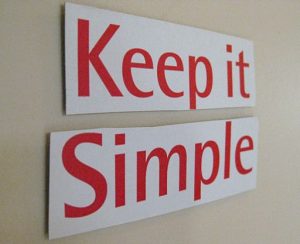12 Organizing a Speech and Harnessing the Power of Three
Lynn Meade

A designer knows he or she has achieved perfection,
not when there is nothing left to add,
but when there is nothing left to take away.
– Nolan Haims, Presentation Coach
also attributed to Antoine de Saint-Exupery
When it comes to speeches there are many formulas for how to present. Once you pick your topic, it is helpful to decide which formula works for you and use it from the start. Sure, you could wing it, but when you run into trouble, you will most likely find yourself seeking out a formula, so it just makes sense to start with an organization plan. Since this is an advanced class, I will review the basics and then talk about ways to take your speech organization to the next level by harnessing the power of three.
Staples of Most Speeches
Every math class I have ever taken starts off with reviewing the basics. Once we review the basics (fractions and decimals) and everyone has a strong foundation, then the class can work on the advanced items. I want to start off by reviewing the basics before we move on to the advanced.
Dale Carnegie wrote, “Tell them what you are going to tell them, tell them, and then tell them what you just told them.” By this, he didn’t mean being senselessly repetitive, but rather he wanted speakers to set up the framework for their speech, tell the audience the main points, and then recap the points.
The basic formula for most speeches follows this pattern:
Grabber/Hook: A statement to get the audience’s attention.
Preview/Big Idea/Thesis statement. This statement is an overview of what the speech is about.
Credibility Statement: Why should the audience listen to you talk about this? Why are you credible on this topic?
Many, but not all speeches, need this.So-What-Who-Cares Statement: A statement telling your audience why this topic suits this audience and this occasion.
This can be achieved as a statement, or it can be sprinkled throughout.Transitions / Signposts: Statements that move the audience from one idea to the next.
Body of Speech: Main points of your speech with transitions between main ideas.
Review: Summary of the speech.
Closure/Cincher: A series of statements that provide closure.

Audiences Will Listen According to Their Understanding of Your Credibility
One important thing to think about when building your speech is how you will build your credibility with the audience. If an audience doesn’t think you are credible, they will listen with suspicion, or they won’t listen at all. In speechmaking, there are three types of credibility–initial, derived, and terminal. Initial credibility is the credibility you have before you start to speak. It comes from any preexisting knowledge they have about you as a speaker, it comes from the way you are introduced, and it comes from the way your presentation was advertised. Next, there is derived credibility–credibility stemming from what you say during your speech, how you present yourself during the speech, and how you manage visuals during the speech. Finally, there is terminal credibility– credibility that you have at the end of the speech. Terminal credibility stems from what they think of how you managed yourself and your topic.
We live in a world where many speakers are “googled”, and their credibility is examined before they ever come in contact with their audience. When I train new teachers, I always have them google their names and see what comes up. To make a strong point, I have them open up their social media with someone else in the room. Once they have their profile pulled up, I ask them to hand their phone to the person next to them. I ask, “If a student looks at your public profiles and your social media, what will they think of you as a teacher?” New teachers are often shocked to think of students looking them up but that is the reality. Whether you are a student, a teacher, or a business professional, you need to be aware that people are looking online and using what they find there to determine your initial credibility.
(Now is a good time to pause and “google” your name and look into your social media to think about your credibility).
So, what makes up your credibility? According to communication researchers McCroskey and Teven, credibility is one part competence, one part trustworthiness, and one part goodwill. Competence is how much an audience member perceives you to be knowledgeable and an expert on the topic. You can boost your competence by using research, by having clear, organized ideas, and by clearly, articulating your ideas. Audiences are quick to form opinions and they are constantly evaluating your honesty and trustworthiness. If an audience deems you untrustworthy, every word out of your mouth will be seen as suspect. Finally, the audience evaluates your caring and goodwill. An audience wants to feel like you have their best intentions in mind. Audiences place a high priority on goodwill.
There are several ways to build your credibility with the audience. You can have someone introduce you who tells the audience why you are speaking on the subject. You can find ways to connect with the audience, so they trust you. The more a speaker shows that they understand and recognize the audience’s feelings, the closer the audience will feel towards the speaker. Demonstrating enthusiasm and passion, managing content respectfully, and showing an awareness of situational factors all can enhance credibility.
Mind the Gap
When mapping out your speech, you should always mind the GAP–goal, audience, and parameters. Always remember what the goal of the speech is, who the audience will be, and what parameters are set by the location, the time limit, and the setting.
Minding the Gap is covered in detail in the chapter on the audience.

Rules for Effective Communication
Frank Lunz, political advisor, and author of Words that Work: It’s Not What You Say, It’s What People Hear, advises politicians of these key components to be an effective communicator.
- Simplicity: Keep the language appropriate for the audience. It is usually better to assume they do not know and explain all terms than it is to leave them with words they don’t understand.
- Brevity: People have limited attention spans so be aware of the speech time. It is better to have fewer points than to have too many points.
- Credibility: People will listen to you to the degree of trust that they have in you.
- Consistency: Make sure what you say agrees with other things you have said. In other words, people look to the context of your life and other messages to interpret what you are saying. It is not uncommon for audience members to “google” a speaker before, during, and after a speech to see if they are trustworthy and consistent with what they say in their speech and in other places.
- Novelty: Find ways to grab attention and stand out.
- Sound and texture: Creative use of words will help attract and hold the audience’s attention.
- Aspiration: Help the audience reflect on how your message taps into them and their goals and dreams. Help them to see more and be more.
- Visualization: Paint vivid pictures with your words to help the audience visualize the story or the outcome.
- Questioning: Turn some statements into questions to engage the audience.
- Context and Relevance: Tell the audience why your speech should matter to them.
Organizing Your Ideas
Nancy Duarte, speech coach was asked, “What’s the best way to start creating a presentation?” Her reply was as follows:
My best advice is to not start in PowerPoint. Presentation tools force you to think through information linearly, and you really need to start by thinking of the whole instead of the individual lines. I encourage people to use 3×5 note cards or sticky notes — write one idea per note. I tape mine up on the wall and then study them. Then I arrange them and rearrange them — just work and work until the structure feels sound.
Finding the Organizational Structure
That is Right for You
To help your travelers understand
what is needed to achieve your vision,
articulate where you need them
to move from and where you need them to move to.
Then make everything in your speech support that transformation.
― Illuminate: Ignite Change Through Speeches,
Stories, Ceremonies, and Symbols
In a study published in Speech Monographs, researchers found that audiences who listened to an unorganized speech were more likely to lose interest. It makes sense that if the speaker is jumping around that we quit trying to follow the message. It also makes sense that their study found that it was harder for audiences to recall the speech information from a disorganized speech. Finally, it is no surprise that disorganized speakers were judged less persuasive and less credible. To maximize the effectiveness of your speech, to make your speech more memorable, and to be seen as more credible, you should use an organized speech pattern.
There are many different formulas for how to organize your speech and I am including a list of the most common structures for you to consider. As a useful activity, you might want to go down the list and figure out how your speech could fit into each of the patterns before you settle on the one that works for you.
When I think about compelling presentations, I think about taking an audience on a journey. A successful talk is a little miracle—people see the world differently afterward.
If you frame the talk as a journey, the biggest decisions are figuring out where to start and where to end. To find the right place to start, consider what people in the audience already know about your subject—and how much they care about it. If you assume they have more knowledge or interest than they do, or if you start using jargon or get too technical, you’ll lose them. The most engaging speakers do a superb job of very quickly introducing the topic, explaining why they care so deeply about it, and convincing the audience members that they should, too.
The biggest problem I see in first drafts of presentations is that they try to cover too much ground. You can’t summarize an entire career in a single talk. If you try to cram in everything you know, you won’t have time to include key details, and your talk will disappear into abstract language that may make sense if your listeners are familiar with the subject matter but will be completely opaque if they’re new to it. You need specific examples to flesh out your ideas. So limit the scope of your talk to that which can be explained, and brought to life with examples, in the available time.
A successful talk is a little miracle—people see the world differently afterward.
Chris Anderson, TED Talk Curator
Informative Speech Patterns
Chronological:
You would format your speech in the order things occurred. First this, then that.
In this talk, America Ferrera describes her step-by-step process of trying to get a role as a Latina in the United States. She takes us on a chronological journey as she wrestles with identity.
As you watch this speech notice how she opens with a story of her as a little girl dancing in the den singing and dreaming. At the end of her speech, she loops back to the nine-year-old girl and ends with power as she expertly points to the audience to bring them in as she delivers a well-thought-out last line:
If I could go back and say anything to that nine-year-old, dancing in the den, dreaming her dreams, I would say, my identity is not my obstacle. My identity is my superpower. Because the truth is, I am what the world looks like. You are what the world looks like. Collectively, we are what the world actually looks like. And in order for our systems to reflect that, they don’t have to create a new reality. They just have to stop resisting the one we already live in.
Compare and Contrast:
You would compare things and point out how they are similar and how they are different.
In this talk, Julie Hogan informs the audience about the concept of cultural humility by comparing and contrasting a Muslim burka and academic regalia.
Cause and Effect:
You would discuss what caused something and what was the overall effect.
In this talk, Caleb Stewart informs his audience of the benefits of reading. He tells all the effects that reading has had on his life.
Problem Solution:
State the problem, tell us why it is a problem, offer us a solution to the problem.
Many of the best talks have a narrative structure that loosely follows a detective story. The speaker starts out by presenting a problem and then describes the search for a solution. There’s an “aha” moment, and the audience’s perspective shifts in a meaningful way.
If a talk fails, it’s almost always because the speaker didn’t frame it correctly, misjudged the audience’s level of interest, or neglected to tell a story. Even if the topic is important, random pontification without narrative is always deeply unsatisfying. There’s no progression, and you don’t feel that you’re learning.
Chris Anderson, TED Talk Curator
In this speech, Bart Knols tells us about the problem with mosquitoes (spoiler alert, it is malaria) and then he informs us of three innovative ways to kill mosquitoes. As you watch, notice how he uses a variety of props–a bed, a box of mosquitos, the slideshow, his boxer shorts to keep his audience engaged. His points are so clear that when his talk is over, you could remember the three main solutions and repeat them to a friend.
Spatial Organization:
Show us a map and move across the map and show us where things are located. This works for more than a map, it could be a blueprint, a piece of art, an object.
Topical Organization:
You would inform us of a topic and how this topic is broken down into subtopics.
Tucker and LeHew in, Exploring Public Speaking, offer this activity and insight:
One of the authors frequently does the following exercise in class. She has all the students take some object from their pocket, purse, or backpack and place it on a table at the front of the room. (It’s interesting what gets put on the table!). Then she has the students gather around and look at the items and “group them”–put them into categories, with each group having at least two items and all items being put in some group. Afterward, she gets the different grouping schema and discusses them. Of course, most of the groups are “correct,” even if just based on color. However, she then asks, “If you had to communicate to a classmate who is absent what is on the table, which schema or grouping pattern would you use?” The point is that grouping can be done on the basis of many characteristics or patterns, but some are clearer and better for communicating.
Less is More
Writer Richard Bach says, “Great writing is all about the power of the deleted word.” Many speakers try to do too much in a speech. They have so much information that they either speak too quickly or explain too briefly. It is better to have fewer points than you can illustrate in numerous ways. After you write your speech, go back, and try to condense. Try to find ways to be more specific and clearer.
It’s a simple equation. Overstuffed equals under-explained.
The wrong way to condense your talk
is to include all the things that you think you need to say,
and simply cut them all back to make them a lot shorter.
There’s a drastic consequence
when you rush through multiple topics in summary form.
Chris Anderson, TED Talk Curator
To make sure the audience gets your point. Tell them what you are going to say, say it, tell them what you’ve said. When you make a point, say the point, illustrate the point with a fact or story, and then tell them how the point applies.
Getting Advanced: The Rule of Three
If you have an important point to make,
don’t try to be subtle or clever.
Use a pile driver.
Hit the point once.
Then come back and hit it again.
Then hit it a third time-a a tremendous whack.
-Winston S. Churchill
Omne Trium Perfectum means everything that comes in threes is perfect. Humans love threes. In our culture, three provides a sense of the whole–it feels complete. The rule of threes suggests ideas presented in threes are easier to remember, more interesting, and more enjoyable. The three could mean have three main points, or the three could mean you have three items to a sentence. It could also mean explaining something in three different ways.
Hendiatris: Three successive words used to express one idea
Friends, Romans, countrymen. William Shakespeare’s Julius Caesar
Life, liberty, and the pursuit of happiness. US Declaration of Independence.
Tricolon: Three parallel words or phrases
Tonight, we gather to affirm the greatness of our nation – not because of the height of our skyscrapers, or the power of our military, or the size of our economy.
Barack Obama, Keynote speech to Democratic National ConventionHomes have been lost; jobs shed; businesses shuttered.
Barack Obama, Inaugural AddressYou learn that duty, honor, and country are not simply words, but guideposts. They dictate what you ought to be, what you can be, what you will be.
Michelle Obama, West Point Banquet
Parallel construction: Repeated phrases
Anaphora: The repeat of exact words at the beginning
A sandal of hope when you reach out.
A sandal of joy when you listen to your heart.
A sandal of courage when you dare to care.
J.A. Gamache, Toastmasters
We can not dedicate
We can not consecrate
We can not hallow — this ground
Abraham Lincoln, Gettysburg AddressIt means to try to tell your kids everything you thought you’d have the next 10 years to tell them in just a few months.
It means to make sure everything is buttoned up so that it will be as easy as possible for your family.
It means to say your goodbyes.
Steve Jobs, Stanford Commencement SpeechThese men are our fathers, grandfathers and even great-grandfathers.
These men have been and will be apart of our lives in ways that go far beyond the Tokyo Raid.
These men are the crews that have made sure our families’ lives were on the right path.
Speech on the Doolittle reunionThis was the moment when the rise of the oceans began to slow and our planet began to heal.
This was the moment when we ended a war, and secured our nation, and restored our image as the last, best hope on Earth.
This was the moment, this was the time when we came together to remake this great nation so that it may always reflect our very best selves and our highest ideals.
Barack Obama Democratic Nomination Victory Speech – Change We Can Believe In
Epiphora: Repeat the words at the end.
There is no Southern problem.
There is no Northern problem.
There is only an American problem.
President Lydon B. JohnsonThis is not, however, just America’s fight.
And what is at stake is not just America’s freedom.
This is the world’s fight.
This is civilization’s fight.
This is the fight of all who believe in
progress and pluralism, tolerance and freedom.
President George Bush, Address to a Joint Session of Congress Following 9/11 Attacks
Have Three Points to Your Speech
Have three main parts to your speech and make sure they are clear.
Now I want to share with you three things I learned about myself that day. I learned that it all changes in an instant. We have this bucket list, we have these things we want to do in life, and I thought about all the people I wanted to reach out to that I didn’t, all the fences I wanted to mend, all the experiences I wanted to have and I never did. As I thought about that later on, I came up with a saying, which is, “I collect bad wines.” Because if the wine is ready and the person is there, I’m opening it. I no longer want to postpone anything in life. And that urgency, that purpose, has really changed my life.
The second thing I learned that day — and this is as we clear the George Washington Bridge, which was by not a lot — I thought about, wow, I really feel one real regret. I’ve lived a good life. In my own humanity and mistakes, I’ve tried to get better at everything I tried. But in my humanity, I also allow my ego to get in. And I regretted the time I wasted on things that did not matter with people that matter. And I thought about my relationship with my wife, with my friends, with people. And after, as I reflected on that, I decided to eliminate negative energy from my life. It’s not perfect, but it’s a lot better. I’ve not had a fight with my wife in two years. It feels great. I no longer try to be right; I choose to be happy.The third thing I learned — and this is as your mental clock starts going, “15, 14, 13.” You can see the water coming. I’m saying, “Please blow up.” I don’t want this thing to break in 20 pieces like you’ve seen in those documentaries. And as we’re coming down, I had a sense of, wow, dying is not scary. It’s almost like we’ve been preparing for it our whole lives. But it was very sad. I didn’t want to go; I love my life. And that sadness really framed in one thought, which is, I only wish for one thing. I only wish I could see my kids grow up.
Alan Alda’s Three Ways to Make Yourself Understood
Some of you may know Alan Alda from the hugely popular show, Mash. Others of you may know him as the host of Scientific American Frontiers. What many people don’t know was he was a visiting professor at Stony Brook University and the founder of the Universities’ Alan Alda Center for Communicating Science. He created that center as a place to train scientists on how to clearly communicate with the public.
In this video, he explains the rule of threes.
- Make no more than three points.
- Explain difficult ideas in three different ways.
- Find a subtle way to make an important point three times.
Key Takeaways
Remember This!
- A speaker should pick a speech pattern that fits the goal, audience, and parameters of the speech
- Following a standard speech pattern helps the speaker be more organized
- Organized speakers are easier to listen to, are perceived as more credible.
- Using the rule of threes can make your speech easier to listen to and more memorable.
Please share your feedback, suggestions, corrections, and ideas.
I want to hear from you.
Do you have an activity to include?
Did you notice a typo that I should correct?
Are you planning to use this as a resource and do you want me to know about it?
Do you want to tell me something that really helped you?
REFERENCES
Anderson, C. (2016). TED Talks: The official TED guide to public speaking. Mariner.
Anderson, C. (2013). How to Give a killer presentation. Harvard Business Review. https://hbr.org/2013/06/how-to-give-a-killer-presentation
Ausubel, D. P. (1968). Educational psychology. Holt, Rinehart, & Winston.
Baker, E. E. (1965). The immediate effects of perceived speaker disorganization on speaker credibility and audience attitude change in persuasive speaking. Western Speech, 29, 148–161.
Belch, G. E., & Belch, M. A. (2001). Advertising and promotion: An integrated marketing communications perspective. McGraw-Hill.
Bush, G.W. (2015). President George W. Bush addresses a joint Congress about the War on Terror. [Video]. YouTube. https://www.youtube.com/watch?v=TYnx-c8pF34 Standard YouTube License.
Bostrom, R. N., & Waldhart, E. S. (1988). Memory models and the measurement of listening. Communication Education, 37, 1–13. https://doi.org/10.1080/03634528809378699
Carnegie, D. (1998). How to win friends and influence people. Pocket Books.
Churchhill Central: Life and words of Sir Winston Churchill. https://www.churchillcentral.com/
Dlugan, A. (2009). How to use the rule of three in your speeches. Six Minutes. How to Use the Rule of Three in Your Speeches (dlugan.com)
Illuminate: Ignite change through speeches, stories, ceremonies, and symbols. Portfolio and Penguin.
Ferrera, A. (2019). My identity is a superpower–not an obstacle. [Video]. YouTube. https://www.ted.com/talks/america_ferrera_my_identity_is_a_superpower_not_an_obstacle/transcript?language=en#t-191931 Standard YouTube License.
Gamache, J.A. (2007). Being Mr. G, JA Gamache, Toastmasters World Championships. [Video]. YouTube. https://www.youtube.com/watch?v=YoW-T2_6OJo Standard YouTuve License
Hogan, J. (2018). The tale of two robes. Julie Hogan. [Video]. YouTube. https://youtu.be/w3Z3jdubP4Y Standard YouTube License.
Jobs, S. (2008). Steve Jobs’ 2005 Stanford commencement address. [Video]. YouTube. https://www.youtube.com/watch?v=Hd_ptbiPoXM Standard YouTube License.
Kalb, I. (2013). Marketers must understand the power of three. Business Insider. https://www.businessinsider.com/using-the-power-of-three-to-your-marketing-advantage-2013-5
Knols, B. (2012). Three new ways to kill mosquitos. [Video]. YouTube. https://www.ted.com/talks/bart_knols_3_new_ways_to_kill_mosquitoes?utm_campaign=tedspread&utm_medium=referral&utm_source=tedcomshare Standard YouTube License.
LeFrancois, G. R. (1999). Psychology for teaching (10th ed.) Wadsworth.
Lineham, D. R. (n.d). Rule of three in speechwriting. https://davelinehan.com/rule-of-three-speechwriting/
McCroskey, J.C. & Teven, J.J. (1999). Goodwill: A re-examination of the construct and its measurement. Communication Monographs. 66(1), 90-103. https://doi.org/10.1080/03637759909376464
McCroskey, J.C. & Mehrley, R.S. (2009). The effects of disorganization and nonfluency on attitude change and source credibility. Speech Monographs. https://doi.org/10.1080/03637756909375604
McCroskey, J.C. & Young, T. J. (1981). Ethos and credibility: The construct and its measurement after three decades. Central States Speech Journal, 32, 24-34. https://doi.org/10.1080/10510978109368075
Obama, B. (2004). Keynote speech to Democratic National Convention. [Video]. YouTube. https://youtu.be/eWynt87PaJ0 Standard YouTube License.
Obama, B. (2008). Obama victory speech-Change we can believe in. [Video]. YouTube. https://www.youtube.com/watch?v=7wJ-2Zu_Iic Standard YouTube License.
Obama, M. (2011). Address at West Point Graduation Banquet. [Video]. YouTube. https://youtu.be/hS01mK7xMDs Standard YouTube License.
Raa Rams. (2018). Raa 2018 Keynote Speaker. [Video]. YouTube. https://www.youtube.com/watch?v=g6OchXV-Mo8 Standard YouTube License.
Smith, R. G. (1951). An experimental study of the effects of speech organization upon attitudes of college students. Speech Monographs, 18, 292–301. https://doi.org/10.1080/03637755109375045
Shu, S. B. & Carlson, K.A. (2014). When three charms but four alarms: Identifying the optimal number of claims in persuasion settings. Journal of Marketing, 78(1). https://doi.org/10.1509/jm.11.0504
Thompson, E. C. (1960). An experimental investigation of the relative effectiveness of organizational structure in oral communication. Southern Speech Journal, 26, 59–69. https://doi.org/10.1080/10417946009371589
Torgovnick May, K. (2012). How to give more persuasive presentations: A Q & A with Nancy Duarte. TED Blog. https://blog.ted.com/how-to-give-more-persuasive-presentations-a-qa-with-nancy-duarte/
Tucker, B. & LeHew, M. (n.d) Exploring public speaking (4th edition). https://alg.manifoldapp.org/projects/exploring-public-speaking
Media Attributions
- Hiway © Karsten Winegeart is licensed under a CC BY (Attribution) license
- john-mark-smith-IS7WfX_f_ug-unsplash © John Mark Smith
- Keep_it_Simple_(3340381990) © Wiki Media: Jimee, Jackie, Tom & Asha is licensed under a CC BY-SA (Attribution ShareAlike) license
- vlad-bagacian-d1eaoAabeXs-unsplash © Vlad Bagacian is licensed under a CC BY (Attribution) license
- Finger-pressing-delete-button © Auaan is licensed under a CC BY-SA (Attribution ShareAlike) license
- tony-hand-C9Ni6Gh_gWk-unsplash © Tony Hand is licensed under a CC BY (Attribution) license




